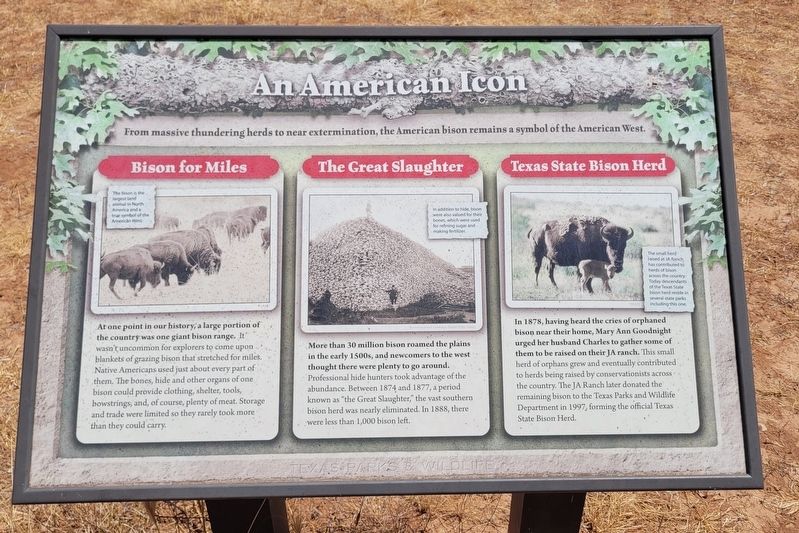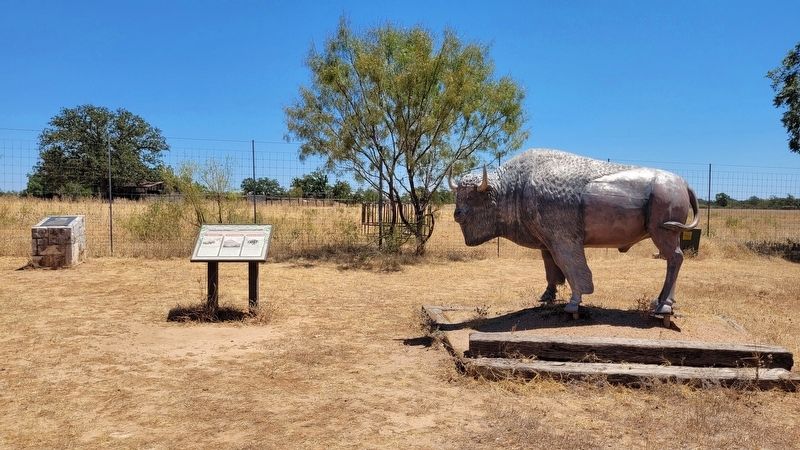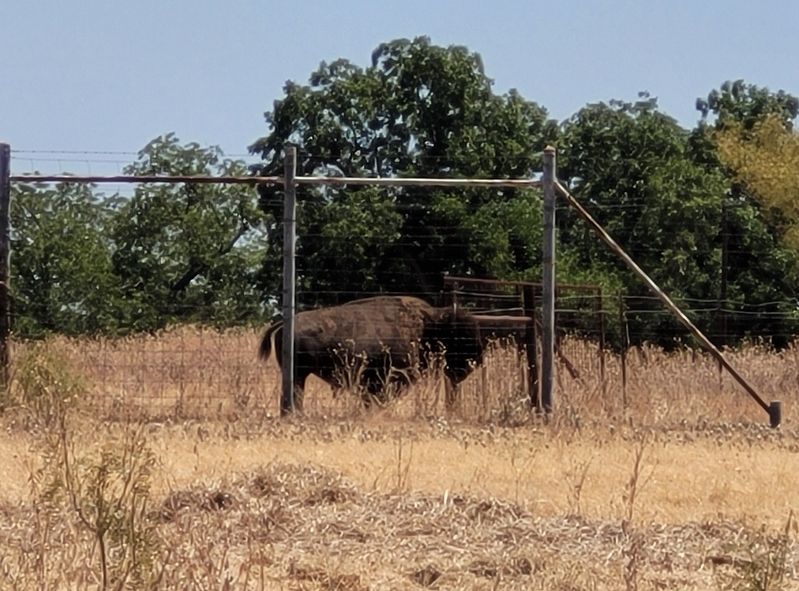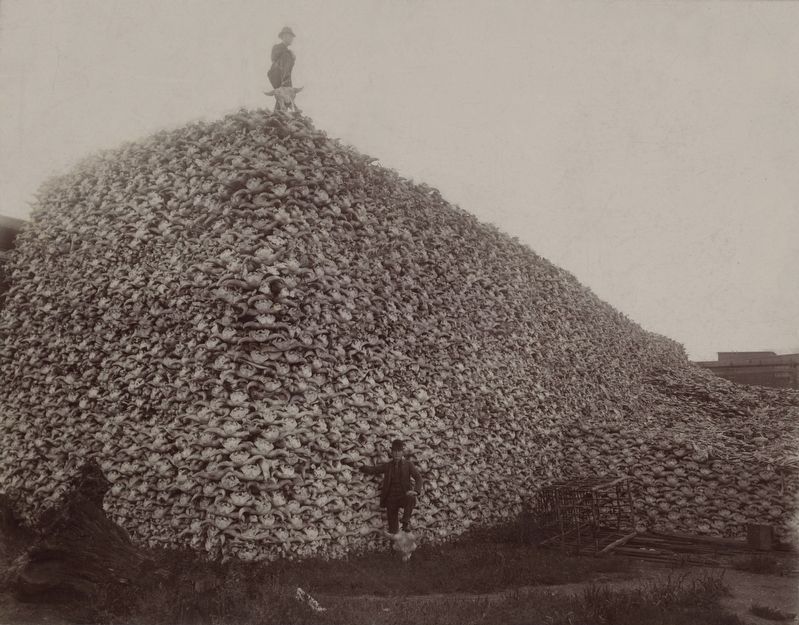Stonewall in Gillespie County, Texas — The American South (West South Central)
An American Icon
Bison for Miles
At one point in our history, a large portion of the country was one giant bison range. It wasn't uncommon for explorers to come upon blankets of grazing bison that stretched for miles. Native Americans used just about every part of them. The bones, hide and other organs of one bison could provide clothing, shelter, tools, bowstrings, and, of course, plenty of meat. Storage and trade were limited so they rarely took more than they could carry.
The Great Slaughter
More than 30 million bison roamed the plains in the early 1500s, and newcomers to the west thought there were plenty to go around. Professional hide hunters took advantage of the abundance. Between 1874 and 1877, a period known as "the Great Slaughter," the vast southern bison herd was nearly eliminated. In 1888, there were less than 1,000 bison left.
Texas State Bison Herd
In 1878, having heard the cries of orphaned bison near their home, Mary Ann Goodnight urged her husband Charles to gather some of them to be raised on their JA ranch. This small herd of orphans grew and eventually contributed to herds being raised by conservationists across the country. The JA Ranch later donated the remaining bison to the Texas Parks and Wildlife Department in 1997, forming the official Texas State Bison Herd.
Captions
Left: The bison is the largest land animal in North America and a true symbol of the American West.
Center: In addition to hide, bison were also valued for their bones, which were used for refining sugar and making fertilizer.
Right: The small herd raised at JA Ranch has contributed to herds of bison across the country. Today descendants of the Texas State bison herd reside several state parks including this one.
Erected by Lyndon B. Johnson National Historical Park.
Topics. This historical marker is listed in these topic lists: Animals • Native Americans • Parks & Recreational Areas. A significant historical year for this entry is 1874.
Location. 30° 14.142′ N, 98° 37.235′ W. Marker is in Stonewall, Texas, in Gillespie County. Marker is on State Park Road 52, ¼ mile north of U.S. 290. The marker is located east of the LBJ State Park Visitors Center. Touch for map. Marker is at or near this postal address: 501 State Park Rd 52, Stonewall TX 78671, United States of America. Touch for directions.
Other nearby markers. At least 8 other markers are within walking distance of this marker. Buffalo (Bison) (here, next to this marker); Sauer-Beckmann Living History Farm (approx. 0.2 miles away); Low Water Crossing (approx. ¼ mile away); Farm History (approx. ¼ mile away); Longhorn Cattle and White-Tail Deer (approx. ¼ mile away); Within These Walls / Small Spaces, Many Faces (approx. 0.3 miles away); What is the President pointing to anyway? (approx. 0.4 miles away); A Grand Entrance (approx. 0.4 miles away). Touch for a list and map of all markers in Stonewall.
Also see . . .
1. Bison hunting. Wikipedia
Bison hunting (hunting of the American bison, also commonly known as the American buffalo) was an activity fundamental to the economy and society of the Plains Indians peoples who inhabited the vast grasslands on the Interior Plains of North America, before the animal's near-extinction in the late 19th century following US expansion into the West. Bison hunting was an important spiritual practice and source of material for these groups, especially after the European introduction of the horse in the 16th through 19th centuries enabled new hunting techniques. The species' dramatic decline was the result of habitat loss due to the expansion of ranching and farming in western North America, industrial-scale hunting practiced by non-Indigenous hunters increased Indigenous hunting pressure due to non-Indigenous demand for bison hides and meat, and cases of a deliberate policy by settler governments to destroy the food source of the Indigenous peoples during times of conflict.(Submitted on November 22, 2023, by James Hulse of Medina, Texas.)
2. American bison. Wikipedia
The American bison, also called the American buffalo or simply buffalo (not to be confused with true buffalo), is a species of bison native to North America. It is one of two extant species of bison, alongside the European bison. Its historical range, by 9000 BCE, is described as the great bison belt, a tract of rich grassland that ran from Alaska to the Gulf of Mexico, east to the Atlantic Seaboard (nearly to the Atlantic tidewater in some areas), as far north as New York, south to Georgia, and according to some sources, further south to Florida, with sightings in North Carolina near Buffalo Ford on the Catawba River as late as 1750.(Submitted on November 22, 2023, by James Hulse of Medina, Texas.)
Credits. This page was last revised on November 22, 2023. It was originally submitted on November 22, 2023, by James Hulse of Medina, Texas. This page has been viewed 46 times since then and 8 times this year. Photos: 1, 2, 3, 4. submitted on November 22, 2023, by James Hulse of Medina, Texas.



